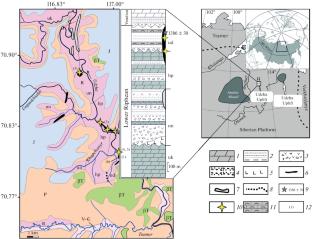An Ultralow Geomagnetic Field Intensity in the Mesoproterozoic Based on Studies of 1380 Ma Old Intrusive Bodies from the Udzha Aulacogen of the Siberian Platform
Abstract—Estimating the time of formation of the Earth’s solid inner core is a first-order problem in the thermal evolution of the Earth as a planet, which can be solved in particular by paleointensity (Banc) determinations. For this purpose, we have studied a collection of ~1380 Ma rocks sampled in the Udzha River valley within the Udzha aulacogen from the dolerite sill near the Khapchanyr River. The sill is an intrusion 5–7 m thick that cuts through the siltstones and carbonates of the Udzha Formation. To obtain reliable paleointensity (Banc) determinations, magnetic and thermomagnetic properties of the studied rocks have been investigated, and their X-ray diffraction patterns and electron-microscopic images have been collected. It is shown that the carriers of the characteristic component of natural remanent magnetization are single-domain (SD) and small pseudo-single-domain (PSD) magnetite grains. Two methods have been used to determine the Banc: the Thellier–Coe procedure including reheating to lower temperatures (the pTRM checkpoints procedure) and the Wilson express method. Paleointensity determinations have been obtained for 9 samples (30 duplicates) that met the selection criteria. The mean value of Banc is extremely low and amounts to 4.54 ± 0.49 μT; the corresponding calculated value of the virtual dipole moment (VDM) is (11.1 ± 1.2) × 1021 Am2, which is almost an order of magnitude lower than the mean VDM in modern epoch (≈80 × 1021 Am2) and more than six times lower than the mean VDM in the Cenozoic (6.44 × 1022 Am2). The VDM data over the 350–3500 Ma interval presented in the world paleointensity database (WPD), Borok, have been analyzed. An alternation of periods of low and high paleointensity is observed in the Precambrian and Paleozoic, which indicates a large variability in the operation mode of the geomagnetic dynamo regardless of the existence or absence of an inner solid core of the Earth. It is important to note that the number of reliable VDM values over such a long interval, 350–3500 Ma, is too small for a complete statistical analysis to single out any time interval as the most probable for the formation of the inner core.


 求助内容:
求助内容: 应助结果提醒方式:
应助结果提醒方式:


